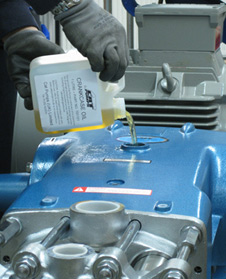- About Us
- What's New
- Products
- Markets & Applications
- Engineered Packages
- Service
- Training
- Literature
- Case Studies
Home > Service
Installed correctly, the Cat Pump will run for many years with very little servicing. A simple preventative maintenance schedule, typically involving only the changing of the crankcase lubricating oil, will eliminate potential problems. Seals will need to be replaced periodically and valves less often. Service manuals are available for all pumps. We believe in providing the highest levels of after-sales support, which is why we also offer a full return-to-base repair and refurbishment service facility at our UK Headquarters.
Service manuals can be downloaded here.
 All Cat Pumps high pressure pumps have an oil reservoir in the crankcase, completely separate from the pump head to prevent intermixing. New pumps are normally supplied without oil to prevent spills in transit and must be filled with the correct quantity of Genuine Cat Pumps Oil listed on the relevant pump Data Sheet. Check the level is on the red dot on the bubble gauge window, or by using the dipstick fitted to some models. Take care to also add the correct oil to any gearbox driving the pump.
All Cat Pumps high pressure pumps have an oil reservoir in the crankcase, completely separate from the pump head to prevent intermixing. New pumps are normally supplied without oil to prevent spills in transit and must be filled with the correct quantity of Genuine Cat Pumps Oil listed on the relevant pump Data Sheet. Check the level is on the red dot on the bubble gauge window, or by using the dipstick fitted to some models. Take care to also add the correct oil to any gearbox driving the pump.
We recommend that you change the pump oil after the first 50 hours of running, and then every 500 hours or three months under arduous running conditions. Drain the old oil whilst the pump is still warm. Refer to the relevant pump Service Manual for more details. Experience shows that these intervals can be extended if the oil looks clean and clear when inspected regularly. Ask us if you are unsure.
If your site policy stipulates a specific manufacturer’s lubricants, ask for an Equivalents List by e-mailing sales@catpumps.co.uk. If you wish to use a Food Grade oil we can recommend and supply an approved lubricant.
Should the temperature of your pump crankcase seem unusually warm, it may be due to a low oil level or contamination. Change the crankcase oil immediately then observe the temperature after a few hours of operation. If the temperature still seems high, it could indicate worn bearings or connecting rods.
If your pump oil turns milky-white this probably means that you have water mixed with the oil. This could be due to washing down, condensation, or prolonged operation with badly worn pump and crankshaft seals which can cause liquid to travel along the plunger rod past the crankcase oil seal. You should service the pump head and crankcase seals, change the oil then increase service intervals and regularly inspect for leaks.
| What's New | ||||||||||||||||||||||||
|
||||||||||||||||||||||||
| Other Links |
| View our latest news |
| Sign up for E-mail Updates |
Literature |
|||
Technical Help |
|||
Troubleshooting |
|||
Contact UsTel: 01252 622031sales@catpumps.co.uk |
|||
|
CERTIFIED MANAGEMENT SYSTEM - ISO 9001:2015 |
|||
|
|
|||
 |
|||